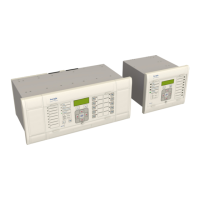Note:
In the logic diagrams and descriptiv
e text, it is usually sufficient to show only the first stage, as the design principles for
subsequent stages are usually the same (or at least very similar). Where there are differences between the functionality of
different stages, this is clearly indicated.
2.2.1 TIMER HOLD FACILITY
The Timer Hold facility is available for stages with IDMT functionality , and is controlled by the timer reset settings
for the r
elevant stages (e.g. I>1 tReset, I>2 tReset ). These cells are not visible for the IEEE/US curves if an inverse
time reset characteristic has been selected, because in this case the reset time is determined by the time dial
setting (TDS).
This feature may be useful in certain applications, such as when grading with upstream electromechanical
overcurrent relays, which have inherent reset time delays. If you set the hold timer to a value other than zero, the
resetting of the protection element timers will be delayed for this period. This allows the element to behave in a
similar way to an electromechanical relay. If you set the hold timer to zero, the overcurrent timer for that stage will
reset instantaneously as soon as the current falls below a specified percentage of the current setting (typically
95%).
Another situation where the timer hold facility may be used to reduce fault clearance times is for intermittent
faults. An example of this may occur in a plastic insulated cable. In this application it is possible that the fault
energy melts and reseals the cable insulation, thereby extinguishing the fault. This process repeats to give a
succession of fault current pulses, each of increasing duration with reducing intervals between the pulses, until the
fault becomes permanent.
When the reset time is instantaneous, the device will repeatedly reset and not be able to trip until the fault
becomes permanent. By using the Timer Hold facility the device will integrate the fault current pulses, thereby
reducing fault clearance time.
2.3 MAGNETISING INRUSH RESTRAINT
Whenever there is an abrupt change of magnetising voltage (e.g. when a transformer is initially connected to a
sour
ce of AC voltage), there may be a substantial surge of current through the primary winding called inrush
current.
In an ideal transformer, the magnetizing current would rise to approximately twice its normal peak value as well,
generating the necessary MMF to create this higher-than-normal flux. However, most transformers are not
designed with enough of a margin between normal flux peaks and the saturation limits to avoid saturating in a
condition like this, and so the core will almost certainly saturate during this first half-cycle of voltage. During
saturation, disproportionate amounts of MMF are needed to generate magnetic flux. This means that winding
current, which creates the MMF to cause flux in the core, could rise to a value way in excess of its steady state
peak value. Furthermore, if the transformer happens to have some residual magnetism in its core at the moment
of connection to the source, the problem could be further exacerbated.
The following figure shows the magnetizing inrush phenomenon:
Chapter 9 - Current Protection Functions P64x
200 P64x-TM-EN-1.3

